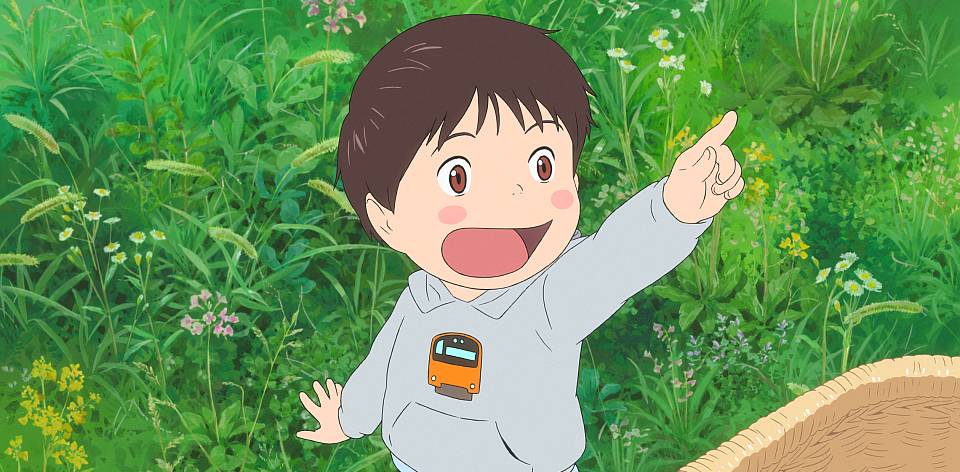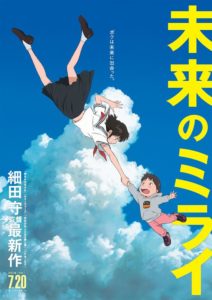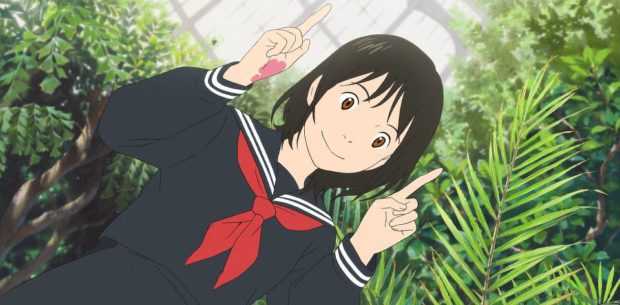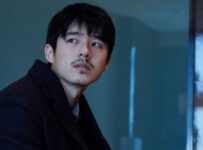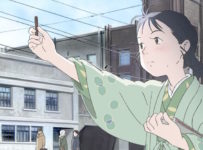While the absence of Studio Ghibli has seen Mamoru Hosoda regularly crowned as the new king of Japanese animation, it’s Disney-Pixar that he recalls in the opening montage of MIRAI (未来のミライ). Depicting the joyous birth of a child through a series of still photos, he begins another multi-generational tale of a Japanese family through the lens of fantasy and imagination. In some ways it’s his most straightforward piece, but perhaps also one of his most personal.
The 4-year old, train-obsessed Kun (voiced by Moka Kamishiraishi) is amazed at the arrival of his new baby sister, who his parents (Gen Hoshino and Kumiko Aso) ultimately name Mirai (meaning “future”). No longer the focus of his parent’s world, he begins to struggle with his place in the family. The back garden soon becomes a magical place that opens up new worlds to him, allowing him to see the perspective of his parents and ancestors when they were children. He’s also paid a visit by a version of his younger sister from the future (Haru Kuroki).
Like the Japanese greats of Yasujirō Ozu or more recently Hirokazu Kore-eda, Hosoda’s skill has always been in crafting tales that examine the intersection of contemporary Japan and traditional family values. It’s just that they also involve time travel and exotic realms. As Hosoda explained in an interview with Variety, MIRAI actually combines a number of themes from his previous works: the “youth” (and time travel) of The Girl Who Leapt Through Time, the “family” aspects of Summer Wars, the “motherhood” of Wolf Children Ame and Yuki, and “fatherhood” in The Boy and the Beast.
It’s clearly a personal story for the filmmaker as well, following the birth of his second child. While ostensibly about Kun, the film also sees Hosoda working through some of his own reflections on being a father. For authenticity, Hosoda has used his own wife’s dialogue for her on-screen avatar, portraying her as stressed and overwhelmed by a lack of support. Hosoda’s own counterpart in the architect father, prone to distraction by work, gradually comes to learn that all those elements of family angst “add up to make us what we are.”
As Kun learns that his parents had similar problems to his own, and finds other male role models in a young version his grandfather (the incomparable Kōji Yakusho), Hosoda’s animation team change their styles to match. To start with, Kun is one of more adorable and energetic male youth leads in a feature anime, with a catalogue of expressions that mirror the countless emotions of being four. The architecturally designed house of the family is one of the most stylish spaces in animation, and no attention to detail has been overlooked. Bauhaus books fill the shelves, and even the software on the MacBooks look authentic.
When Kun enters the garden, the animators get to cut loose. Kun morphs into a dog, dives into an aquatic landscape, and flies over the city. Each era Kun visits has a distinct colour palatte as well, such as the distinctive post-War setting of his grandfather’s timeline. It culminates in a dazzling blend of CG and traditional animation in an extended Tokyo Station set-piece, an Escheresque maze of clocks and trains.
The sequence might be a little terrifying for the younger audience members, as Kun and Mirai are drawn into the red-glow of a living Bullet Train. Yet it’s swiftly followed with an innovative trip down the Family Index, a digital tree reminiscent of the Summer Wars aesthetic, where each line connects to a leaf representing a stage in life. Takagi Masakatsu returns to collaborate with Hosoda on the lively score, capturing the mystery and wonder of youth.
MIRAI might be an update on a Dickensian morality tale, but it’s a ridiculously charming one. Hosoda doesn’t take too many chances narratively, but nevertheless finds an accessible and universal way of exploring the complex relationship between children and their parents. If nothing else, it might just remind you to be a little nicer to your parents and siblings, as you never know when one of them is going to pay you a visit from the future.
[stextbox id=”grey” bgcolor=”F2F2F2″ mleft=”5″ mright=”5″ image=”null”] 2018 | Japan | DIR: Mamoru Hosoda | WRITER: Mamoru Hosoda | CAST: Moka Kamishiraishi, Haru Kuroki, Gen Hoshino, Kumiko Aso | DISTRIBUTOR: Madman Films, Sydney Film Festival (AUS) | RUNNING TIME: 100 minutes | RELEASE DATE: 20 July 2018 (SFF), 16 June 2018 (Japan) [/stextbox]
2018 | Japan | DIR: Mamoru Hosoda | WRITER: Mamoru Hosoda | CAST: Moka Kamishiraishi, Haru Kuroki, Gen Hoshino, Kumiko Aso | DISTRIBUTOR: Madman Films, Sydney Film Festival (AUS) | RUNNING TIME: 100 minutes | RELEASE DATE: 20 July 2018 (SFF), 16 June 2018 (Japan) [/stextbox]

